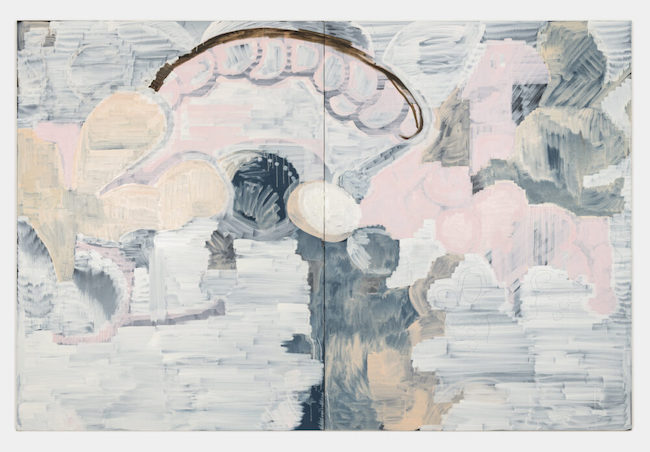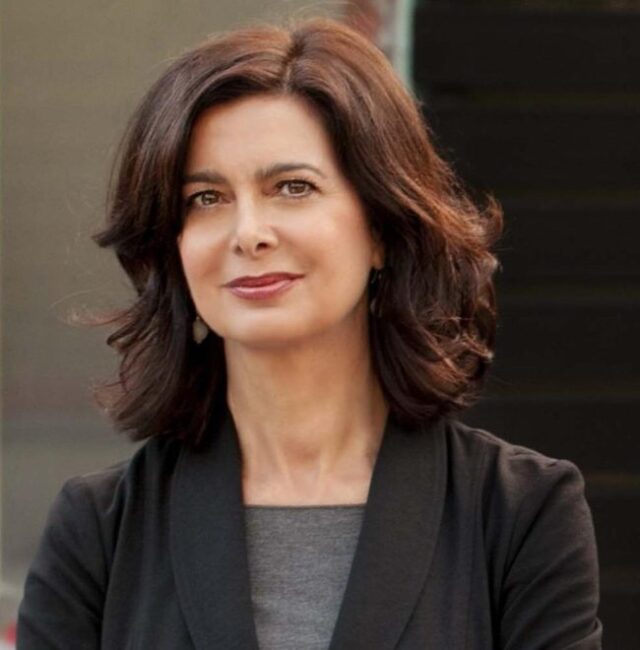Molto spesso gli artisti tendono a trasformare il gesto pittorico in emanazione di tutto quel mondo interiore che altrimenti non sarebbero in grado di esprimere, svelando un approccio all’esistenza quasi opposto a un’apparenza più impostata, meno morbida, permettendo all’osservatore di scoprire che spesso il percorso della creazione conduce a un contatto interiore così profondo da permettere l’ascesa di sensazioni ed emozioni che non possono che tradursi sulla tela nello stesso modo in cui affiorano alla coscienza. Questo tipo di cammino creativo conduce spesso verso un informalismo funzionale a seguire un impulso che non potrebbe essere arginato dalla definizione dell’immagine o dalla consapevolezza emergente da un disegno preparatorio, bensì necessita di fluire senza alcun ostacolo formale. Il protagonista di oggi è interprete di un linguaggio legato al puro istinto ma emanato con una leggerezza cromatica che va a toccare le corde più sensibili di chiunque si trovi davanti a una sua tela.
Intorno alla metà del Novecento, quando gli Stati Uniti divennero la patria delle avanguardie più coinvolgenti di quegli anni spostando dunque dall’Europa il centro della nascita dei movimenti artistici, vide la luce a New York uno stile osteggiato dai grandi salotti culturali e dal circuito dei musei, perché ritenuto non all’altezza del Realismo apprezzato negli ambienti aristocratici che ancora dettavano le regole dell’arte, al punto da essere escluso dalla grande mostra collettiva sull’arte americana organizzata dal Metropolitan Museum. Era il 1950 e il gruppo indignato per l’esclusione era l’Espressionismo Astratto, così definito per la caratteristica di voler fortemente affermare l’esistenza di un’arte informale che sfuggisse a qualsiasi contenimento formale, come invece era accaduto per gli altri movimenti precedenti in cui la geometria era divenuta la gabbia della non forma. Jackson Pollock, Barnett Newman, Mark Rothko, Willem de Kooning e Robert Motherwell reagirono riunendosi nel Greenwich Village per contrastare questa opposizione delle istituzioni; da quel momento l’Espressionismo Astratto cominciò a prendere via via più piede e ad accogliere nelle sue fila tutti quegli artisti che volevano scegliere l’impulso espressivo come unica regola esecutiva, e che soprattutto volevano sentirsi liberi di raccontare le proprie emozioni senza doversi attenere ad alcuno schema. Il Dripping, più impulsivo e primordiale, quasi violento nel gesto esecutivo, era più affine a personalità ingestibili e ribelli come quella di Pollock, mentre la pittura segnica, altrettanto istintiva ma più controllata, era scelta da quei personaggi come Franz Kline per i quali la preparazione concettuale era fondamentale; e ancora la monocromia di Barnett Newman, che lo fa rientrare di diritto nel Minimalismo, era l’estremizzazione del Color Field di Mark Rothko. Fu proprio quest’ultima tecnica a dare maggiori possibilità interpretative, declinate e personalizzate da altri appartenenti al movimento come Helen Frankenthaler, in cui l’intensità cromatica di Rothko veniva attenuata dalla presenza di da tenui sfumature compositive, o dall’utilizzo di tonalità più delicate, più morbide e a volte impalpabili. L’unica linea guida a cui gli artisti aderenti alla corrente pittorica che di fatto dominò l’universo informale della seconda metà del Ventesimo secolo e che si diffuse anche in tutta Europa, era quella di imprimere le proprie emozioni, le sensazioni più profonde nelle loro tele, come se dall’opera dovessero spingersi verso l’esterno e comunicare direttamente con l’osservatore che a quel punto viene letteralmente avvolto dalla suggestione da un punto di vista istintivo, senza alcuna mediazione da parte della mente.
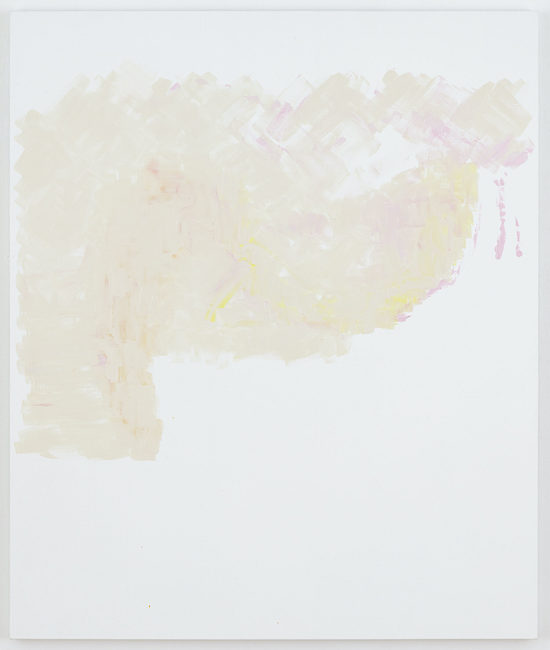
È esattamente in questo contesto che si inserisce la produzione artistica del tedesco Michael Krebber, che schiarisce la gamma cromatica per tendere verso un riferimento lirico a quell’interiorità che necessita di comunicare al di fuori del sé, e che si manifesta con la medesima timidezza e riservatezza che probabilmente prova l’autore nel momento in cui entra in contatto con la tela alla quale però non riesce a resistere, generando così un mondo in bilico tra ciò che deve essere detto e la tendenza a sussurrare piuttosto che a propagare con forza verso l’esterno.
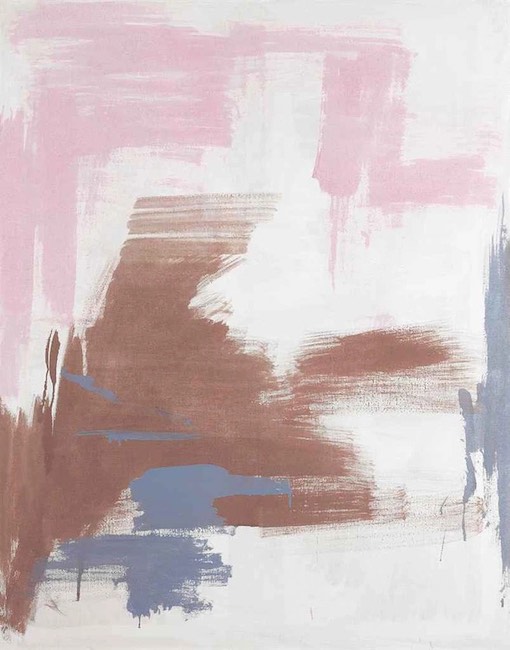
La rappresentazione è dunque soffice e malgrado la tecnica dell’olio o dell’acrilico su tela evoca le impalpabili sfumature degli acquarelli, soprattutto perché gli sfondi sono prevalentemente bianchi e su di essi agisce per far fuoriuscire in punta di piedi le sue sensazioni, il suo punto di vista che rimane sempre misurato, avvolgente ma al contempo consapevole di dover andare a interagire con un’altra essenza diversa dalla propria e dunque necessitante di un approccio mai invasivo.
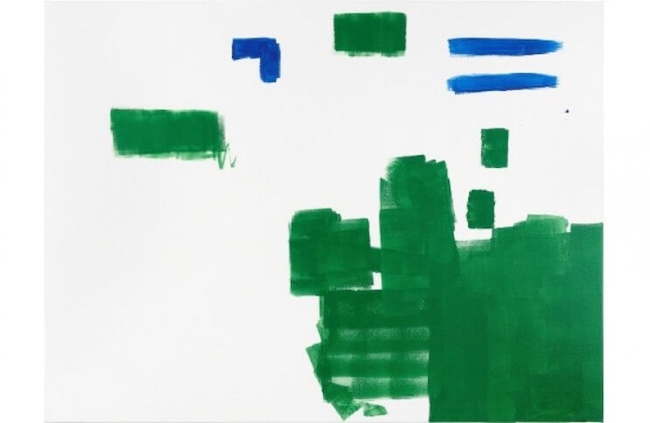
In qualche modo l’evanescenza della gamma cromatica sembra ispirarsi agli acquarelli cinesi e giapponesi, con il loro riprodurre la bellezza di luoghi che sembrano essere sospesi tra il cielo e la natura; Michael Krebber sembra lasciar intuire una sottile figurazione, come a suggerire l’esistenza di una sostanza diversa da quella dell’osservato, un qualcosa di più sottile che si concretizza proprio nel momento in cui la sensazione affiora verso l’esterno e che si rarefà non appena prova ad assumere maggiore consistenza. La fuggevolezza di tutto ciò che circonda l’essere umano emerge dalle sue tele in maniera sottile, intangibile eppure fortemente percepibile in virtù della suggestione che l’artista riesce a creare senza invadere, entrando con discrezione nell’ambiente che accoglie i suoi dipinti fino a far diffondere lentamente l’eco dei suoi pensieri. Alla maggior parte dei lavori Michael Krebber non dà titoli proprio per sottolineare l’assoluta relatività di un messaggio che si modifica sulla base del ricevente e che dunque deve essere interiorizzato senza alcun condizionamento, in maniera libera proprio perché il rapporto con l’arte è intimo, personale, e la tela diviene uno specchio delle emozioni del fruitore; senza un riferimento logico l’emotività è libera di vagare e di entrare all’interno di quel mondo silenzioso, di quelle atmosfere avvolgenti perché morbide, tenui al punto di attrarre per la totale mancanza di un eccesso espressivo che andrebbe a interagire in maniera diversa da quella che è l’intenzione narrativa dell’artista.
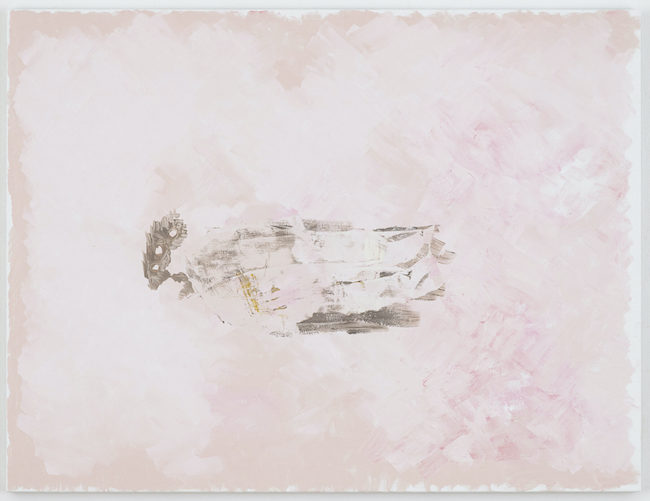
In Untitled 2021 la base rosa cipria si estende sull’intera superficie della tela, come a sottintendere la necessità di considerare quanto sia necessario all’essere umano ritrovare il bello dell’esistenza, quella purezza perduta a causa di una contemporaneità che sembra voler distaccare l’uomo dalla sua vera natura, inducendolo a perdersi dentro valori effimeri incapaci di farlo sentire mai davvero soddisfatto proprio perché mancanti della sostanza di cui l’individuo ha bisogno. Il centro dell’opera è più scuro per rappresentare quel nucleo, quel fulcro che affonda le radici in un passato diverso, più orientato verso un umanesimo che di fatto non è e non sarà mai dimenticato, e dunque Michael Krebber ricorda all’osservatore di cercare dentro se stesso, nell’intimità della sua interiorità avvolta dalla morbidezza del rosa tenue che appare come una nuvola protettiva.
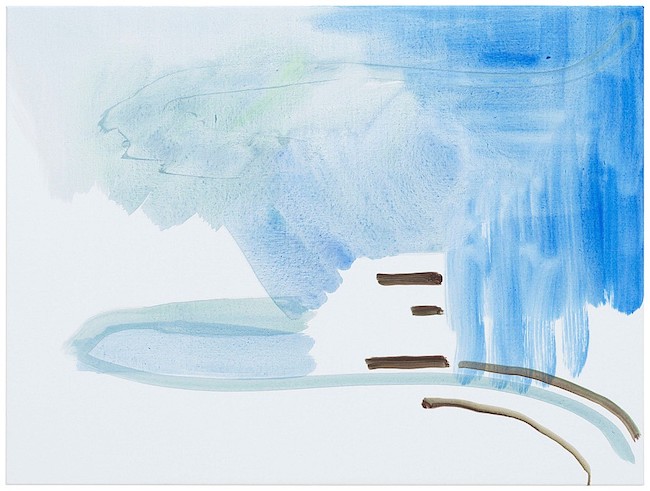
In Ohne Titel 1-2019 invece lo sfondo è bianco, come a sottolineare la necessità di porsi in posizione di ascolto di tutto ciò che fuoriesce perché per percepire le parole più sottili e segrete è necessario avvolgere lo spazio di silenzio, solo così sarà possibile lasciar entrare il sogno, rappresentato da un lieve e sfumato celeste, quella dimensione privilegiata in cui la coscienza si abbandona, abbassa le difese permettendo alla fantasia o al possibilismo di mostrare una versione diversa delle cose. Il colore arriva dal lato in alto a destra e poi sembra voler scendere fino a riempire la tela, come se Michael Krebber suggerisse che lasciarsi andare a tutto ciò che appartiene alla creatività può dare un equilibrio impensato, può infondere quiete e serenità spesso irraggiungibili solo attraverso la determinazione e l’approccio razionale.
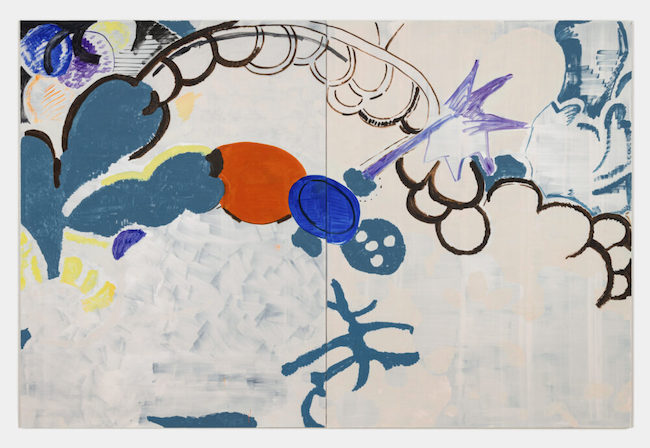
In La poupée invece la figurazione entra in maniera più evidente all’interno dell’opera, pur sempre rimanendo però indefinita, dunque l’evocazione di un qualcosa di più materiale come una bambola, che in ogni caso appartiene al regno dei giochi e della fantasia, induce l’artista a cercare un contatto più forte con l’osservato, come se la connessione con la capacità immaginativa di un bambino necessitasse una maggiore concretezza che però resta sempre in bilico, viene sempre accompagnata dall’impalpabilità che contraddistingue l’artista.
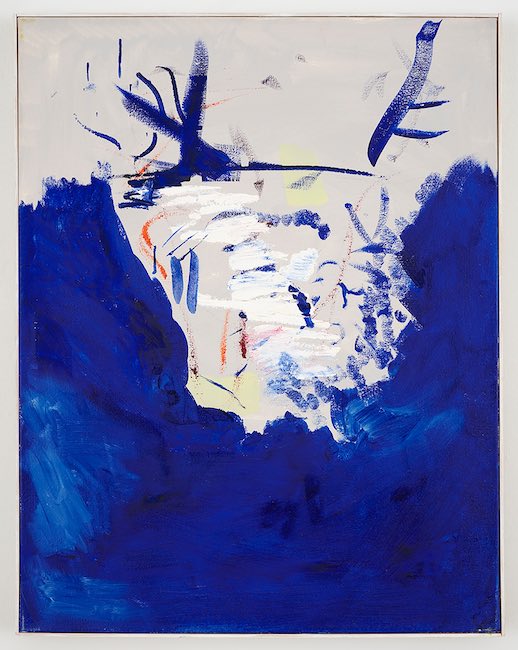
Michael Krebber ha al suo attivo mostre personali presso importanti istituzioni internazionali come la Fondazione Antonio Dalle Nogare di Bolzano, il Museum Brandhorst a Monaco di Baviera, il Greene Naftali di New York, la Kunsthalle di Berna, il Serralves Museum of Contemporary Art di Porto, il Museum Ludwig di Colonia e il CAPC Musée d’art Contemporain di Bordeaux e le sue opere fanno parte delle collezioni di alcuni tra i più importanti musei sia negli Stati Uniti che in Europa.
MICHAEL KREBBER-CONTATTI
Email: info@greennaftaligallery.com
Sito web: www.greenenaftaligallery.com/artists/michael-krebber
Michael Krebber’s expressive delicacy, when Abstract Expressionism tends towards Minimalism to show the impalpable lightness of being
Very often artists tend to transform the pictorial gesture into an emanation of that inner world that they would otherwise not be able to express, revealing an almost opposite approach to existence to a more set, less soft appearance, allowing the observer to discover that often the path of creation leads to an inner contact so profound as to allow the rise of sensations and emotions that cannot but translate onto the canvas in the same way as they surface to consciousness. This type of creative journey often leads towards an informalism that is functional to following an impulse that could not be contained by the definition of the image or by the awareness emerging from a preparatory drawing, but rather needs to flow without any formal obstacle. Today’s protagonist is the interpreter of a language linked to pure instinct but emanated with a chromatic lightness that touches the most sensitive chords of anyone standing in front of one of his canvases.
Around the middle of the twentieth century, when the United States became the home of the most enthralling avant-gardes of those years, thus shifting the centre of the birth of artistic movements from Europe, a style saw the light in New York that was opposed by the great cultural salons and the museum circuit, because it was considered not up to the standards of Realism appreciated in the aristocratic circles that still dictated the rules of art, to the point of being excluded from the great collective exhibition on American art organised by the Metropolitan Museum. It was 1950 and the group outraged by the exclusion was Abstract Expressionism, so defined for its characteristic of wanting to strongly affirm the existence of an informal art that escaped any formal containment, as instead had happened with the other previous movements in which geometry had become the cage of non-form. Jackson Pollock, Barnett Newman, Mark Rothko, Willem de Kooning and Robert Motherwell reacted by gathering in Greenwich Village to oppose this opposition of the institutions; from that moment on, Abstract Expressionism began to gain ground and to welcome into its ranks all those artists who wanted to choose the expressive impulse as their only executive rule, and who above all wanted to feel free to tell their emotions without having to adhere to any scheme. Dripping, more impulsive and primordial, almost violent in its executive gesture, was more akin to unmanageable and rebellious personalities like Pollock‘s, while sign painting, equally instinctive but more controlled, was chosen by those figures like Franz Kline for whom conceptual preparation was fundamental; and again Barnett Newman‘s monochrome, which rightfully make him belonging to Minimalism, was the extreme of Mark Rothko‘s Colour Field.
It was precisely this latter technique that gave greater interpretative possibilities, declined and personalised by other members of the movement such as Helen Frankenthaler, in which Rothko‘s chromatic intensity was toned down by the presence of subtle compositional nuances, or by the use of more delicate, softer and sometimes impalpable tones. The only guideline followed by the artists adhering to the painting current that in fact dominated the informal universe of the second half of the 20th century and that also spread throughout Europe, was that of imprinting their emotions, their deepest sensations in their canvases, as if from the artwork they had to push outwards and communicate directly with the observer who at that point is literally enveloped by the suggestion from an instinctive point of view, without any mediation by the mind. It is exactly in this context that fits the artistic production of the German Michael Krebber, who lightens the chromatic range to tend towards a lyrical reference to that interiority that needs to communicate outside the self, and which manifests itself with the same shyness and reserve that the author probably feels when he comes into contact with the canvas that however he cannot resist, thus generating a world poised between what needs to be said and the tendency to whisper rather than to propagate forcefully outwards. The representation is therefore soft and despite the technique of oil or acrylic on canvas evokes the impalpable nuances of watercolours, especially because the backgrounds are predominantly white and he acts on them to tiptoe out his sensations, his point of view that always remains measured, enveloping but at the same time aware of having to interact with another essence different from his own and therefore needing an approach that is never invasive. Somehow the evanescence of the chromatic range seems to be inspired by Chinese and Japanese watercolours, with their reproduction of the beauty of places that seem to be suspended between the sky and nature; Michael Krebber seems to hint at a subtle figuration, as if to suggest the existence of a substance other than that of the observed, something more subtle that materialises at the very moment when the sensation emerges towards the outside and that rarefies as soon as it tries to take on greater consistency.
The fleetingness of everything that surrounds the human being emerges from his canvases in a subtle, intangible yet strongly perceptible manner by virtue of the suggestion that the artist manages to create without invading, entering discreetly into the environment that welcomes his paintings until the echo of his thoughts slowly spreads. Michael Krebber does not give titles to most of his artworks in order to emphasise the absolute relativity of a message that changes on the basis of the receiver and must therefore be internalised without any conditioning, in a free manner precisely because the relationship with art is intimate, personal, and the canvas becomes a mirror of the emotions of the viewer; without a logical reference, emotiveness is free to wander and to enter into that silent world, those atmospheres that are enveloping because they are soft, tenuous to the point of attracting due to the total lack of an expressive excess that would interact in a manner different from the artist’s narrative intention. In Untitled 2021, the powder-pink base extends over the entire surface of the canvas, as if to imply the need to consider how necessary it is for human beings to rediscover the beauty of existence, that purity lost due to a contemporaneity that seems to want to detach man from his true nature, inducing him to lose himself in ephemeral values incapable of ever making him feel truly satisfied precisely because they lack the substance that the individual needs.
The centre of the work is darker to represent that core, that fulcrum rooted in a different past, more oriented towards a humanism that in fact is not and will never be forgotten, and thus Michael Krebber reminds the observer to search within himself, in the intimacy of his interiority enveloped by the softness of the soft pink that appears like a protective cloud. In Ohne Titel 1-2019, on the other hand, the background is white, as if to emphasise the need to place oneself in a position of listening to all that escapes, because in order to perceive the most subtle and secret words, it is necessary to envelop the space in silence, only in this way will it be possible to let in the dream, represented by a light, shaded celestial, that privileged dimension in which consciousness abandons itself, lowers its defences, allowing fantasy or possibilism to show a different version of things. The colour arrives from the top right-hand side and then seems to want to descend until it fills the canvas, as if Michael Krebber were suggesting that letting go of everything that belongs to creativity can give an unthought-of balance, can instil tranquillity and serenity often unattainable only through determination and a rational approach.
In La poupée, on the other hand, figuration enters more clearly into the artwork, but always remains undefined, so the evocation of something more material such as a doll, which in any case belongs to the realm of games and fantasy, induces the artist to seek a stronger contact with the observed, as if the connection with the imaginative capacity of a child required a greater concreteness, which however always remains in the balance, is always accompanied by the impalpability that characterises the artist. Michael Krebber has to his credit solo exhibitions at important international institutions such as the Antonio Dalle Nogare Foundation in Bolzano, the Brandhorst Museum in Munich, the Greene Naftali in New York, the Kunsthalle in Berne, the Serralves Museum of Contemporary Art in Oporto, the Museum Ludwig in Cologne and the CAPC Musée d’art Contemporain in Bordeaux, and his paintings are part of the collections of some of the most important museums in both the United States and Europe.


